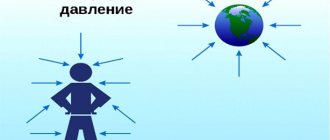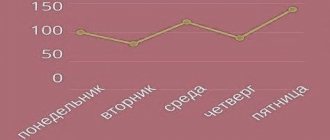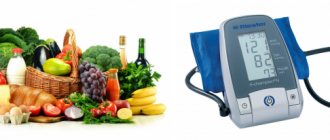Normal blood pressure for an adult is 120/80. Deviations of 10 points are allowed. When the indicators remain stable and the person feels good, this pressure is called working pressure.
If it changes sharply, it poses a danger to life, because it negatively affects the functioning of various organs and can result in death, and the cause can be either too low or too high values. Previously, such problems were characteristic only of older people, but now similar things can happen to young people.
Very high, as well as very low blood pressure is dangerous for humans
What it is?
The main organ of human life is the heart. This is a pump for pumping blood, supplying oxygen to all organs and systems of the body. For this reason, there are several phases in the functioning of the heart muscle:
- diastole;
- systole.
Based on the parameters of the functioning of the heart muscle in humans, the upper and lower limits of blood pressure are distinguished. Its sharp fluctuations are characterized by their ability to affect the body in a negative way: high and low pressure are unsafe for life.
If earlier the quantitative ratio of people suffering from high blood pressure (hypertension) was much higher than those with low blood pressure (hypotension), now the situation is changing dramatically. Heart and vascular diseases occupy one of the leading places in mortality throughout the world. The disease itself is also getting younger. If before this time older people suffered from coronary artery disease, now this disease is becoming younger.
Terminal condition: signs of impending death
Before death occurs, that is, the biological shutdown of all human systems, natural and nature-provided changes occur in the body, one of which is a sharp decrease in readings on devices that record pressure (lower and upper). Also, indications of the functioning of systems and organs indicate the approach of biological death. There are general medical signs by which one can judge the beginning of the pre-death stage: lack of oxygen causes hypoxia (brain and tissues), the processes responsible for the inflow and outflow of blood are inhibited, and the following also occurs:
- change in the structure of the blood - its acidification;
- it becomes difficult for a person to breathe.
And also the lowest blood pressure in a person at the moment of approaching death is recorded in the stage of agony. Immediately before death, the pressure decreases greatly - the duration of the terminal state can last from several seconds to 4-5 minutes.
Standard indicators
Blood pressure is the force acting on the blood vessels. The definition of “arterial” refers to vascular pressure parameters. There are:
- venous;
- capillary;
- heart pressure.
Standard blood pressure indicators for vital functions are 120/80 (maximum 140/90). If the value is too high, there is a tendency towards hypertension. Maximum - the upper pressure is systolic, the heart muscle contracts. Minimum – diastolic (relaxation phase).
To determine the optimal blood pressure value, it is not necessary to focus on established standards. A person may well have individual characteristics of blood pressure. If there are non-standard indicators, you should pay close attention to your health and consult a doctor.
Pulse is an indicator of blood pressure. The norm for humans is 60-80 beats. /min. By measuring your heart rate, you can learn about an upcoming problem. If the number of heartbeats increases after 2-3 hours after eating, food poisoning can be detected. During magnetic storms, a decrease in blood pressure is observed. In response to this, the heart rate increases to maintain optimal blood pressure levels.
Age norms for blood pressure
The state of the body directly depends on age, physical activity, habits, and psycho-emotional stress. Typically, by the age of 50, a person already has a number of chronic diseases. As you age, your blood pressure also changes.
To determine blood pressure (BP), a special device is used - a tonometer. It records the maximum blood ejection at the time of contraction of the heart muscle - systolic pressure, and the minimum level - diastolic pressure.
There are certain age standards for acceptable blood pressure levels:
In a healthy person, a blood pressure of 120/80 mmHg is considered normal. Art., while the difference between systolic and diastolic indicators should vary within 30-55 mm Hg. Other values indicate disturbances in the functioning of the body. Frequent decreases or increases in values lead to pathological changes in the cardiovascular system and impaired cerebral circulation.
Fatal outcomes from sudden changes in blood pressure also occur in healthy people. At what pressure you can die will directly depend on a combination of negative factors, the condition of the blood vessels and the heart.
Reasons for measuring blood pressure
The reasons for changing the parameters are as follows:
- Lack of ability of the heart muscle to function normally, as before.
- Changes in blood quality parameters. As you age, your blood thickens. The higher the degree of its density, the harder it moves through the vessels. The causes of blood thickening can be diabetes and autoimmune pathological diseases.
- Decreased elasticity of blood vessels. The causes of this condition are poor nutrition, exceeding the limit of permissible physical activity, and a certain list of medications.
- The formation of atherosclerotic plaques that appear in the bloodstream as a result of high concentrations of “bad” cholesterol in the body.
- A sharp decrease in the lumen of blood vessels, provoked by hormones.
- Incorrect activity of the endocrine system.
Probable etiology of the problem
The reasons that cause a state of high blood pressure with a decreased rhythm of the heart muscle may be the following:
- 1. Heart pathologies.
- 2. Diseases of the thyroid gland and endocrine system. Hormonal imbalance often causes difficulties in the functioning of the vascular system.
- 3. Frequent use of medications that have side effects on the heart.
- 4. Adaptation of patients with hypertension during the period of change of place of residence and changes in temperature.
- 5. Excessive fatigue and increased mental stress.
Critical indicators
Critical pressure is the value at which the main load falls on the heart and vascular system, which affects the condition. Sharp fluctuations in blood pressure lead to disruption of the cardiovascular system.
It is impossible to indicate the exact parameters of critical pressure for humans. An overestimated blood pressure value by 20-30 points from the maximum permissible is dangerous, more than 30 is a critical indicator. Here is the critical pressure for a person:
- below 100/60 – hypotension;
- above 140/90 – hypertension.
Deadly high blood pressure, when the tonometer reaches a value of 300, in a similar situation death occurs. Hypertensive crisis – 260 to 140. Critical low pressure – 70/40 or less.
The maximum permissible level provokes the occurrence of heart failure; if the symptoms are ignored, death occurs.
If a patient’s temperature rises against the background of a blood pressure failure, this is an alarming signal. Critical temperature and pressure are especially dangerous for people with coronary heart disease, diabetes, heart failure, atherosclerosis and arrhythmia.
Be careful, sometimes a combination of such symptoms accompanies myocardial infarction. And the temperature may rise slightly.
Norms by age group
Medical indicators for this parameter are considered ideal when the numbers on the tonometer are 120/80. It is important to take into account a certain feature - a person’s normal blood pressure can change with age. Here is an example of such changes:
For people in the older age group, indicators of 110/70 can affect their well-being:
- noticeable loss of strength;
- an attack of dizziness.
Important! Over time, as inevitable biochemical processes occur in the body, blood pressure gradually increases, so the limit at which one can judge the development of pathological changes shifts.
You should always pay attention to your health status. If your normal blood pressure has been low throughout your life, and then it changes to 120/80 or higher, accompanied by general malaise, then you should consult a doctor. Conversely, if the usual level was always 130/90, and then it began to drop to the normal 120/70 values, then in this case it is also necessary to make an appointment with a specialist.
Why does blood pressure rise?
Pressure fluctuations don't just happen. Blood pressure values are influenced by factors that are not always related to the incorrect functioning of the body. Increased blood pressure - review of lifestyle and diet.
Factors that cause increased blood pressure:
- Dehydration. The norm for human fluid intake is 2 liters, the water must be clean. In the absence of the required amount of water, the blood thickens, the heart functions at the maximum permissible speed, which provokes an increase in blood pressure.
- Eating fatty foods with significant cholesterol levels. Cholesterol plaques settle on the walls, interfering with the movement of blood through the vessels.
- High salt intake.
- Having bad habits.
- Frequent heavy physical activity, as well as lack thereof. With increased loads, disruptions in orgasm are observed, with physical inactivity, the outflow of blood worsens, and the strength of the heart muscle weakens.
- Frequent stressful situations.
- Heredity, menopause, kidney failure, head injuries.
Causes of low blood pressure
It is influenced by the following factors:
- Stress, emotional tension.
- Mental and physical stress.
- Labor activity (underground work, in wet rooms, extreme conditions, workshops with high temperatures, with acids and alkalis).
- Diseases of the central nervous system, heart and blood vessels, adrenal glands, thyroid gland.
- Static.
Important! Hypotension is observed in athletes as a protective reaction in the presence of constant physical activity.
The danger of high blood pressure
An increased blood pressure value entails irreversible processes in the body. A significant portion of the hazardous impact occurs on the activity of the heart and blood vessels. Every year, about a million people die worldwide due to CVD disease, with the majority dying as a result of hypertension.
An increased blood pressure value is accompanied by hypertensive crises - sharp fluctuations in pressure to a critically dangerous level.
Hypertensive crisis is a sudden increase in blood pressure to 180/110 or more. If after 5 minutes the pressure does not change, you need to urgently take measures to reduce the levels. A long stay in such a state is fraught with the development of complications: stroke, swelling in the lungs, acute failure of the heart. In view of this, priority assistance is provided immediately.
Hypertensive crisis occurs:
- Uncomplicated. There are no serious disruptions in the performance of the heart muscle, brain, or kidneys. After several hours of taking the medications, blood pressure normalizes.
- Complicated. Its occurrence is extremely rare. In this condition, the digestive organs come under attack.
During a hypertensive crisis, a sharp expansion of blood vessels and their ruptures are observed. The patient complains of migraines and pain in the heart, fever, nausea, and vision deterioration. Complications that pose a particular mortal danger include heart attack and stroke. In the chronic course of hypertension, vital organs - the heart, kidneys, eyes - are affected:
- a stroke is accompanied by a sudden deterioration in blood circulation in the structures of the brain, paralysis occurs, which can remain for life;
- renal failure - metabolic failures, the kidneys cannot perform their functions - urine formation;
- When the eyes are affected, vision deteriorates and hemorrhage is observed in the eyeball.
When diagnosing hypertension, traditional treatment methods should not be excluded. On the contrary, they are used as an addition to the general course of therapeutic treatment, and their use is agreed upon with the therapist. Diuretic preparations are used in combination with drug treatment. Chopped cranberries with honey help a lot.
How to understand that he is dying
Life expectancy depends on the quality of health.
Any malfunction in the functioning of organs and systems can greatly undermine a person’s immunity. It is especially necessary to closely monitor the functioning of the cardiovascular system. To do this, you need to know at what pressure a person’s death occurs and how to avoid a critical condition. Sudden pressure surges to certain standards can cause serious brain and heart complications and cause death. To prevent the loss of a loved one, it is necessary to remember under what pressure a person dies. Each organism has its own critical indicator. There is an opinion that an increase or decrease in blood pressure by 30 points from the usual state is life-threatening.
Experts cannot give an exact figure at what pressure death occurs. It is believed that the maximum the body can withstand is a blood pressure of 260/140 mmHg. Art., then the person dies. A decrease in diastolic blood pressure leads to worsening blood circulation. The result may be the development of heart failure, hypoxia, and loss of consciousness.
It is necessary to understand at what pressure a person dies and when he needs emergency help. A sharp decrease in pressure by 30 mm Hg. Art. can cause certain sensations and cardiogenic shock, which is accompanied by cardiac arrest. In most cases this leads to death.
The main sign of disorders in the cardiovascular system is constantly stable high or low blood pressure. In the first case, a person is diagnosed with hypertension, in the second - hypotension. However, both pathologies require appropriate therapy.
To normalize blood pressure, a person is forced to take the necessary medications and other additional means, as well as constantly monitor blood pressure levels so as not to worsen his health condition. What lethal pressure is for a person will be discussed in this article.
If your loved one is terminally ill, accepting that they will soon be gone can be incredibly difficult. Knowing what to expect can make things easier.
This article examines 11 signs that death is approaching and discusses ways to cope with the death of a loved one.
When a person is terminally ill, they may be in hospital or receiving palliative care. It is important for loved ones to know the signs of approaching death.
With the onset of death, human organs stop working, and all processes in the body stop. All you can do in this situation is just be there. Show concern and try to make the last hours of the dying person as comfortable as possible.
Continue to talk to the dying person until he passes, because often the dying person hears everything that is happening around him until the last minute.
A significant increase or decrease in blood pressure poses a serious threat to human life and can cause the development of pathologies of the heart, circulatory system, and kidneys. The scientists concluded that the prognosis for patient survival worsens both at too high and at critically low blood pressure values. Lethal pressure for a person with hypertension is above 180/110 mmHg. Art., and with hypotension – below 45 mm Hg. Art.
People suffering from hypertension notice a progressive increase in blood pressure levels. With pathological hypertension, narrowing and spasm of blood vessels occurs, the disease develops after suffering a psycho-emotional shock, with atherosclerosis, coronary artery disease.
Another cause of high blood pressure is excessive blood viscosity: the body tries to speed up blood flow, and therefore the pressure rises. The number of contractions of the heart muscle increases, and vascular tone increases. With excessive blood viscosity, blood clots form and blood vessels become blocked; the pathology is complicated by infarction and tissue necrosis, to which O₂ and essential nutrients cease to flow.
An increase in the total volume of circulating blood in the body also increases blood pressure. This condition is observed with excessive consumption of table salt, metabolic disorders, and diabetes mellitus.
I. Blood pressure readings up to 140–150/90–100 mm Hg are recorded. Art.
II. Marks on the tonometer reach 150–170/95–100 mm Hg. Art.
III. Blood pressure exceeds 180/110 mm Hg. Art.
At the initial stage, short attacks occur, internal organs are not affected. In moderate forms of hypertension, blood pressure rises more often and medications are required to reduce it.
The third stage is characterized by high blood pressure levels and disruption of target organs. Dystrophic changes occur in the myocardium, the walls of blood vessels thicken and lose elasticity, blood supply to peripheral tissues deteriorates, and vision problems arise. Against the background of a critical increase in pressure, a hypertensive crisis, hemorrhagic stroke, heart attack, heart and kidney failure develop. Without assistance, death occurs.
Hypotension is accompanied by insufficient blood supply to the brain and heart, tissues experience oxygen starvation. With prolonged hypotension, a heart attack, stroke develops, death or severe disability occurs.
There are physiological and pathological decreases in blood pressure. Normally, blood pressure may drop after intense sports training, overwork, or when climbing mountains. Pathological hypotension occurs against the background of stress, endocrine diseases, dysfunction of the kidneys, heart and vascular system.
Arterial hypotension is diagnosed when the tonometer readings drop to 80/60 mmHg. Art. and less. The pathology occurs in acute or chronic form. With the rapid progression of the disease, the symptoms of hypotension appear suddenly and increase rapidly. A decrease in blood pressure occurs over a short period of time, and the development of cardiogenic, orthostatic shock, and loss of consciousness is possible. Without timely assistance, a person dies.
Impaired peripheral circulation leads to a lack of oxygen; the brain and internal organs suffer from hypoxia. A person’s health deteriorates, dizziness, weakness appear, fog appears before the eyes, noise in the ears, and fainting occurs.
With chronic low blood pressure, dangerous complications develop less frequently. In some cases, blood pressure readings of 85–90/60 are also recorded in healthy people who do not suffer from any diseases, so blood pressure readings are individual for each person.
In case of hypotension, it is important to increase and stabilize blood pressure. This requires the use of hormonal drugs that increase vascular tone: Adrenaline, Prednisolone. Stimulates the central nervous system and brain chemoreceptors Cordiamine. The medicine speeds up breathing, inhalation becomes deeper, the body begins to receive more oxygen, blood pressure normalizes, and health improves.
To increase pressure when the volume of circulating blood decreases, infusions of colloidal and saline solutions are made: Sodium chloride, Reopoliglucin. If the cause of low blood pressure is heart failure, intravenous administration of glycosides is prescribed: Corglicon, Digoxin.
Patients often ask the question: at what pressure is it necessary to call an ambulance? Emergency treatment is required for fainting, increased blood pressure more than 180/110, or a decrease in systolic value less than 45 mmHg. Art. Before the doctor arrives, you can take the medicine that the patient drinks constantly, put a Nitroglycerin tablet under the tongue.
In severe cases of hypertension, crisis, blood pressure is lowered with the help of diuretics, β-blockers, ACE inhibitors, neurotransmitters, alpha-2-adrenergic receptor agonists of the brain, Enalaprilat. If systolic readings reach 200 mm Hg. Art., to lower blood pressure, the patient is prescribed Clonidine, Nifedipine, Prazosin. The drugs are selected by the attending physician individually for each patient, taking into account what disease caused the pathology.
Manifestations of low blood pressure are associated with disturbances in blood flow and insufficient oxygen supply to the brain and heart muscle.
Symptoms of low pressure affecting the brain:
- Pain in the head - does not go away until 72 hours, intensifies after mental stress, after leaving a state of sleep. The pain reacts sharply to light and noise. Localization of pain in the temporal part of the head and in the frontal part;
- Dizziness - often morning dizziness, as well as dizziness with a sudden change in body position;
- Increased irritability - a hypotensive person is in a constant state of apathy, increased fear and anxiety;
- Decreased or partial memory loss - a hypotensive person is unable to concentrate and perform work that requires increased mental stress. With oxygen starvation of the cerebral cortex, fluid (cerebrospinal fluid) can accumulate in the ventricles of the brain space and the dangerous disease hydrocephalus of the cerebral cortex develops. With this disease there is a risk of strokes. Also, dropsy of the brain causes irreparable pathology in the transmission of impulses in the nervous system.
Symptoms of oxygen starvation of the heart due to low pressure:
- Cardiopalmus;
- Pain behind the chest - a rapid pulse is recorded. The pain is stabbing in nature, a feeling of compression of the heart muscle. If you have this symptom, you should not take Nitroglycerin. This drug is dangerous in this situation and can make the diastolic pressure zero.
Symptoms of disorders in the digestive organs due to oxygen starvation:
- Spasms in the intestines, chronic constipation;
- Disgust from the smell of food;
- Nausea leading to vomiting;
- Flatulence, belching during and after meals.
Any bleeding reduces blood pressure by up to 15% of normal.
The danger of hypotension during bleeding, both open type and hidden type of bleeding. Bleeding from the uterus in the female body that occurs for more than 5 calendar days is dangerous. Prolonged bleeding from the uterus is a signal to visit a gynecologist.
Low pressure danger
Hypotension affects the condition. When it is present, the organs experience a lack of blood and there is insufficient blood supply to the body. Critical lower pressure is equated to dangerous, when oxygen does not enter the main vessels, and there is poor blood supply to organs. Poor blood circulation in the brain increases the chance of an ischemic stroke.
Hypotension affects well-being: the patient complains of malaise, fatigue, and impotence. Heart attack, stroke, heart and vascular diseases are a complicated course of hypertension and hypotension. A large number of examples confirm the possibility of transition from hypotension to hypertension. This is explained by the fact that pathological changes are observed in the vessels. This type of hypertension is very difficult for the body to tolerate than other cases.
Important! Hypotension is observed at the initial stage of pregnancy. Dehydration requires drinking a lot of fluids, but this affects the child's condition.
When should you call emergency services?
Both hypertension and hypotension require emergency care . Therefore, in case of a sharp and sudden rise (fall) in blood pressure to individual values, it is necessary to call qualified medical assistance, otherwise this may lead to irreversible consequences.
A sharp change in blood pressure, both upward and downward, is dangerous. When these conditions are identified, emergency assistance is required, which can only be provided by qualified specialists. Therefore, if hypo- or hypertension is detected, an ambulance should be sought, where normal blood pressure numbers will be achieved through the administration of medications.
Actions of the patient in the presence of dangerous pressure
Hypertension and hypotension require mandatory treatment. The earlier therapy is started, the better for the person. Sudden drops in high blood pressure are undesirable - this harms the body and poses a danger to humans. For treatment, drugs with a combined type of action are used, the main task of which is to reduce side effects and increase benefits. The modern pharmaceutical industry is engaged in the production of drugs that reduce high blood pressure for 24 hours after a single dose.
General recommendations for reducing critical pressure:
- Reduce salty intake.
- Avoid drinking coffee, tea, and alcoholic beverages.
- Eliminate animal fats and sugar.
- Increase the amount of fresh fruits and vegetables you consume.
- Consume foods containing large amounts of potassium and magnesium.
Usually the patient knows what the critical low pressure is for him and can quickly increase it at home. To increase vascular tone, there is no point in using pills. Coffee is considered an affordable remedy for quickly raising blood pressure. Preparations containing caffeine - Citramon, Pyramein, Askofen.
Cinnamon water can quickly increase low pressure - 1 teaspoon of cinnamon is poured with boiling water, and 2 teaspoons are drunk to increase pressure. For hypotension, it is necessary to use drugs with a combined spectrum of action - a combination of ACE inhibitors and potassium antagonists, an ACE inhibitor and a diuretic.
People with problematic blood pressure are wondering what pressure is considered critical and which conditions are worse: hypertension or hypotension? Any violation poses a danger. If pressure surges are systematically observed, you should immediately seek qualified help. After a thorough examination of the patient, the doctor will prescribe the necessary medications and preventive measures.
Here's what causes blood pressure problems:
- heredity;
- stress;
- excessive physical activity;
- weather change;
- passive lifestyle;
- bad habits;
- unbalanced diet;
- heart and vascular diseases.
Symptoms of high and low blood pressure
Hypertension:
- mild and moderate increase (severe form of hypertension can occur hidden if its development was gradual, without the presence of sharp jumps in blood pressure);
- pressing pain in the back of the head;
- noise in ears;
- stiffness of movements;
- chest pain;
- anxiety.
Hypotension:
- lethargy;
- drowsiness;
- rapid fatigue;
- decreased level of performance;
- aching headache;
- frequent fainting.
Important! Symptoms appear when the weather changes. With orthostatic hypotension, there is sudden weakness with the presence of floaters and darkening before the eyes.
Characteristic symptoms
In case of hypertension, when blood pressure is elevated and the tonometer shows numbers of 140/100 mmHg. Art. and more, a person is worried about a severe, throbbing headache, dizziness, decreased hearing and vision. If the attack is not stopped in a timely manner, the patient becomes worse. Symptoms are more disturbing: nausea, sometimes accompanied by vomiting, muscle weakness, increased sweating, redness of the skin of the face, neck, and chest.
With low blood pressure, the signs are:
- pain in the head, localized in the back of the head and temples;
- severe dizziness and loss of coordination;
- weakness, drowsiness, apathy;
- tremor of limbs, chills;
- paleness of the skin;
- memory impairment;
- nausea;
- ringing in the ears and blurred vision.
The lowest pressure can provoke deep fainting, brain hypoxia, heart failure and cardiac arrest. Therefore, if the indicators drop to 80 to 80 or below, it is considered a critical situation.
Hypertension or hypotension?
Patients often wonder which of the critical pressure values is worse. In a comparative analysis of the conditions, it is obvious that in terms of the dangerous consequences of complications, hypertension is worse than hypotension. The ideal value is normal blood pressure according to medical experts.
Achieving ideal pressure parameters for hypotension is possible with the use of tonic drinks containing caffeine, ginseng and other stimulants. For hypertensive patients, systematic consumption of special medications that control blood pressure is mandatory.
Most of the causes of sharp fluctuations in critical blood pressure can be eliminated on your own, which will make it possible to preserve your health for a longer time. A properly selected, balanced diet, activity and physical activity, a calm attitude towards events in life, avoidance and elimination of stressful situations is the path to health and longevity. Compliance with these simple rules will normalize blood pressure levels.











